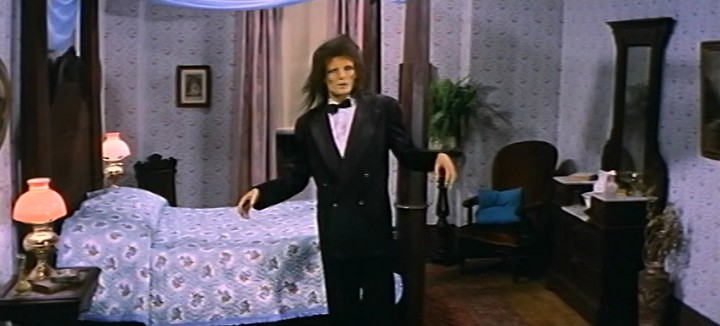When a post-Grinch Boris Karloff appears in a composite Caribbean island in Isle of the Snake People, he looks like the Gringo Abuelo of the people. The movie takes liberties with the identity of the natives but it makes up for it with incredibly specific rituals, depicted with a low-budget immediacy typically relegated to New York in the sixties. It also poses a question about what rules voodoo actually violates (which it answers when clouds of women descend on single men and literally eat them in the street). But the zombies are precious, and when Karloff’s right-hand man starts doing naughty things with them, he’s punished, demonstrating that the religiously ordained zombie condition is a servile but protected state, and that the undead are sacrileges to natural law but sacred ghouls to the right people. It’s all so exotic, exquisite and terribly like young love.
A less-religious, even comical investigation of undead management comes in the form of King of the Zombies. Mantan Moreland makes this mainstream curiosity double as a comic vehicle for the black film circuit, along with a sly investigation of the slave/master dynamic that can only be laughed off by ignorant whites. (Sugar Hill offers a feminist, Blaxsploitation view of the matter.)
Stewardship and home ownership factor in with such modern consequences, as well. With landowners acting as the invisible agents behind resurrected laborers, the ownership of property becomes an oddly ephemeral element with regard to Caribbean zombies. In Blood of the Zombie a landowner doubles as a priestess to mobilize servants (and a dead brother) to win ownership of her family’s plantation—she lives in a literal zombie house years before any “fiscal bubble” burst.
Romero suggests his shambling sacrilegious hoards are the result of our tampering with “science,” so why isn’t the green movement using zombies as poster children? Jean Rollin’s Grapes of Death suggested pesticides could make killer zombies, and that wasn’t precisely deliberate (not much feels deliberate with Rollin), but we’ve all gone past the fear of our crazy leaders and into the fear that we’re incompetents entrusted with the keys to the city. The result has to be environmental destruction.
As z-grade as J-zombies tend to be, Japanese filmmakers still martial their videogame and graphic novel based undead to make comments on the state of their environment. Battle Girl’s dead revive when a meteor hits Tokyo Bay releasing “cosmo-amphetamines” (clearly bad for air quality), Versus puts zombies—and reincarnation—into a nature preserve-like “Resurrection Forrest,” and Stacy makes zombiehood something only healthy schoolgirls suffer…you know, like a menses. OneChanbara is easy to dismiss because the video game adaptation is a giant excuse for half-dressed women to fight like ninjas, but, like the other three films I mentioned, emphasize Japan’s disintegrating social fabric, in particular how fathers cower when called on to protect their children. These are not the guys who “know what to do when the zombie apocalypse comes,” but they are all missing a time they consider “simpler,” or at least, with clearer guideposts.
Wild Zero is like Japan’s Six String Samurai fortified with undead. Grumpy aliens revived them to fight a Rockabilly band—SO much pomade. The biggest lesson this spoof-fest has to offer is that to “Prevent Juvenile Delinquency” we need to “Protect Sincerity.” More than any overt reference or alienating premise about brainlessness, this statement cues Romero.
Roy Frumkes‘s Document of the Dead is lousy with loving interviews, but it begins with footage of Martin, Romero’s modern vampire drama, which it uses to establish Romero’s jubilant affection for irony. It’s heady, of course, and the “vampire” is an emotionally damaged guy who’s name and pursuit of affection resembles Ernest Borgnine’s in a sweeter story of social dysfunction, but what Frumkes highlights here is just how bent Romero’s vampire is, and by extension, how bent his “ghouls” are. If Romero did anything, he bent that zombie for mass production.
It’s not for nothing the first scene of Night of the Living Dead is Johnny heckling Barbara for praying at a family grave. “They’re coming to get you, Barbara,” was nearly an indictment of late night horror. You can laugh too, because Johnny doesn’t look like a juvenile delinquent, he just talks like one.
There’s something very comforting about how consistent these hoard zombies are, even when variations occur, they’re always just corpses, reanimated. It’s so simple the predictability becomes pleasing! Some eat live flesh, others brains, some work for a “living” but they all lost their spiritual heft when they went white-bread and now they’re not unique examples of heathen sacrilege anymore, they’re just brainless and directionless, and as we learn in Romero’s Dawn of the Dead, the mall’s the best place for them. Capitalist consumption metaphors finally see it Lugosi’s way, with one caveat: the loonies run the asylum. That’s what you get when you give up on religious leaders; you’re in charge. Ugh.
It’s hilarious that when the dead return to France, the country sees them not as a curse but as a bureaucratic problem. They Came Back doesn’t even address “human rights” for the resurrected, they just start finding shelter, food and money to provide for their needs. Imagine the tax hikes! This isn’t consumer criticism; it’s a parable of fiscal responsibility. It helps to mention that, while some returnees are brown, none are green, which alleviates racial dynamics.
My favorite proto-zombie is the voiceless, Australian Patrick, whom you could argue isn’t undead so much as comatose, telepathic and maybe evil. What Patrick does is challenge the prevailing notion of death. The matron who oversees his everlasting life support calls him “a daily reminder of medicine’s ability to prolong death instead of life” but the doctor who attends him sees him as an opportunity to study “this play area between life and death.” Patrick still gets plenty of action from the relative safety of his bed, and in his lack of shambling he’s a unique example of the dead “revived.” He’s all agency, and in a way that’s a frothy example of the threat of the undead—that they’re more than they appear, that we could become them, or worse already are them, but especially that their utter meaninglessness is less desperately thrust on them than hollowly claimed—out with a whimper, awaiting the bang.
For “I, Zombie,” part I, see this article on Keyframe.






